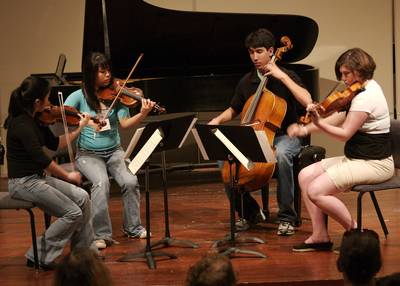Defining Chamber Music - A Moving Target
December 3, 2010
 These days, with string quartets playing Jimi Hendrix and clarinet quintets playing latin jazz, the definition of what constitutes chamber music is becoming blurred. I got into this today during an interesting conversation with Susan Bates, a long-time string player in the Bay Area and board member of the local service and grant-making organization, San Francisco Friends of Chamber Music (SFFCM).
These days, with string quartets playing Jimi Hendrix and clarinet quintets playing latin jazz, the definition of what constitutes chamber music is becoming blurred. I got into this today during an interesting conversation with Susan Bates, a long-time string player in the Bay Area and board member of the local service and grant-making organization, San Francisco Friends of Chamber Music (SFFCM).
SFFCM defines chamber music as: "music performed by two or more players, with one player per part and no conductor."
Hearing this definition, and given our conversation about crossover groups like Quartet San Francisco and the Turtle Island Quartet that use the string quartet format to bring jazz, folk, latin, rock and other formats to concert halls normally reserved for the playing of quartets by Haydn, Mozart and Beethoven, I asked Susan: "Does this mean that a rock group, which has two or more members, each playing one to a part and no conductor, would also be eligible for a grant from SFFCM?"
Susan admitted that the definition of chamber music is a moving target and that SFFCM is constantly updating its ideas on what constitutes the art form in today's world. But it seems that rock groups, despite meeting the criteria for defining chamber music as set out by SFFCM, wouldn't really be eligible to become a member of the organization or apply for funding from it.
Here's what Susan said by way of explanation:
"We have not had rock groups approach us. What we feel we're looking for is not traditional in genre, but traditional in terms of the everyday life of a chamber musician. This means consistent membership and a lot of rehearsing. You could say that of a rock group of course. It's an ongoing discussion. We have nothing against rock music. But we're here to help classical musicians where assistance and financial backing are not so readily present. We also want to preserve an art form that comes from the world of classical music, though we also support early music, jazz and cross-genre ensembles. It's hard to draw a line. We're there to assist the best quality artists we can who don't necessarily have much visibility with the general public. Our mission is to keep vital the art form. But as the art form changes, the definition may change too."
I wonder what would happen if a Bay Area rock band were to apply to SFFCM??



0 Comments:
Post a Comment
<< Home